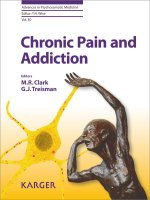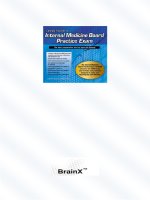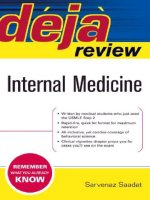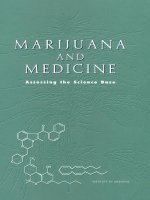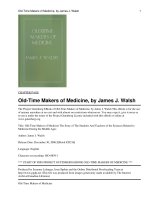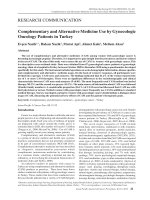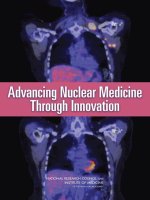Evidence-based Medicine Toolkit ppt
Bạn đang xem bản rút gọn của tài liệu. Xem và tải ngay bản đầy đủ của tài liệu tại đây (2.96 MB, 114 trang )
Evidence-based
Medicine Toolkit
SECOND EDITION
Carl Heneghan
Centre for Evidence-based Medicine
Department of Primary Health Care
University of Oxford
Old Road Campus
Headington
Oxford
OX3 7LF
AND
Douglas Badenoch
Minervation Ltd
7200 The Quorum
Oxford Business Park North
Oxford
OX4 2JZ
Evidence-based
Medicine Toolkit
SECOND EDITION
Evidence-based
Medicine Toolkit
SECOND EDITION
Carl Heneghan
Centre for Evidence-based Medicine
Department of Primary Health Care
University of Oxford
Old Road Campus
Headington
Oxford
OX3 7LF
AND
Douglas Badenoch
Minervation Ltd
7200 The Quorum
Oxford Business Park North
Oxford
OX4 2JZ
© 2002 BMJ Books
© 2006 Carl Heneghan and Douglas Badenoch
Published by Blackwell Publishing Ltd
BMJ Books is an imprint of the BMJ Publishing Group Limited, used
under licence
Blackwell Publishing, Inc., 350 Main Street, Malden, Massachusetts
02148-5020, USA
Blackwell Publishing Ltd, 9600 Garsington Road, Oxford OX4 2DQ, UK
Blackwell Publishing Asia Pty Ltd, 550 Swanston Street, Carlton, Victoria
3053, Australia
The right of the Authors to be identifi ed as the Authors of this Work has been
asserted in accordance with the Copyright, Designs and Patents Act 1988.
All rights reserved. No part of this publication may be reproduced, stored in
a retrieval system, or transmitted, in any form or by any means, electronic,
mechanical, photocopying, recording or otherwise, except as permitted
by the UK Copyright, Designs and Patents Act 1988, without the prior
permission of the publisher.
First published 2002
Second edition 2006
1 2006
A catalogue record for this title is available from the British Library and the
Library of Congress
ISBN-13: 978-0-7279-1841-3
ISBN-10: 0-7279-1841-9
Set in 8.25/10 pt Frutiger by Sparks, Oxford – www.sparks.co.uk
Printed and bound in India by Replika Press Pvt. Ltd, Harayana
For further information on Blackwell Publishing, visit our website:
The publisher’s policy is to use permanent paper from mills that operate
a sustainable forestry policy, and which has been manufactured from
pulp processed using acid-free and elementary chlorine-free practices.
Furthermore, the publisher ensures that the text paper and cover board used
have met acceptable environmental accreditation standards.
v
Contents
Introduction, 1
Asking answerable questions, 3
Finding the evidence: how to get the most from your searching, 7
Critical appraisal of guidelines, 21
Appraising systematic reviews, 27
Appraising diagnosis articles, 34
Appraising articles on harm/aetiology, 42
Appraising prognosis studies, 46
Appraising therapy articles, 50
Appraising qualitative studies, 59
Appraising economic evaluations, 65
Applying the evidence, 71
Evidence-based medicine: glossary of terms, 79
Selected evidence-based healthcare resources on the web, 86
Levels of evidence, 94
Study designs, 97
Index, 101
This handbook was compiled by Carl Heneghan and Douglas Badenoch.
The materials have largely been adapted from previous work by those who
know better than us, especially other members of the Centre for Evidence-
based Medicine (Chris Ball, Martin Dawes, Karin Dearness, Paul Glasziou ,
Jonathan Mant, Bob Philips, David Sackett, Sharon Straus).
1
Introduction
Asking
answerable
clinical
questions
Finding the best
evidence
Appraising the
evidence
Making a
decision
Evaluating your
performance
Patient
Intervention
Comparison
Outcome
Secondary sources
Primary sources
Is it valid?
Is it important?
Can it help?
How much will it help your
particular patient?
Does it meet their values and
goals?
Is it cost-effective?
How could you do it better
next time?
2 Evidence-based Medicine Toolkit
This ‘toolkit’ is designed as a summary and reminder of the key
elements of practising evidence-based medicine (EBM). It has
largely been adapted from resources developed at the Centre for
Evidence-based Medicine. For more detailed coverage, you should
refer to the other EBM texts and web pages cited throughout.
The fi rst page of each chapter presents a ‘minimalist’ checklist of
the key points. Further sections within each chapter address these
points in more detail and give additional background information.
Ideally, you should just need to refer to the fi rst page to get the
basics, and delve into the further sections as required.
Occasionally, you will see the dustbin icon on the right. This
means that the question being discussed is a ‘fi lter’ question for
critical appraisal: if the answer is not satisfactory, you should con-
sider ditching the paper and looking elsewhere. If you don’t ditch
the paper, you should be aware that the effect it describes may not
appear in your patient in the same way.
Defi nition of evidence-based medicine
Evidence-based medicine is the ‘conscientious, explicit and judi-
cious use of current best evidence in making decisions about indi-
vidual patients’.
This means ‘integrating individual clinical expertise with the
best available external clinical evidence from systematic research’
(Sackett et al. 2000).
We can summarize the EBM approach as a fi ve-step model:
1 Asking answerable clinical questions.
2 Searching for the evidence.
3 Critically appraising the evidence for its validity and relevance.
4 Making a decision, by integrating the evidence with your clinical
expertise and the patient’s values.
5 Evaluating your performance.
3
Asking answerable questions
The four elements of a well-formed clinical question are:
1 Patient or Problem
2 Intervention
3 Comparison intervention (if appropriate)
4 Outcome(s)
The terms you identify from this process will form the basis of your
search for evidence and the question as your guide in assessing its
relevance.
Bear in mind that how specifi c you are will affect the outcome
of your search: general terms (such as ‘heart failure’) will give you a
broad search, while more specifi c terms (for example, ‘congestive
heart failure’) will narrow the search.
Also, you should think about alternative ways or aspects of de-
scribing your question (for example, New York Heart Association
Classifi cation).
Element Tips Specifi c example
Patient or problem Starting with your
patient ask ‘How would
I describe a group of
patients similar to mine?’
‘In women over
40 with heart
failure from dilated
cardiomyopathy …’
Intervention Ask ‘Which main
intervention am I
considering?’
‘… would adding
anticoagulation
with warfarin to
standard heart failure
therapy…’
Comparison
intervention
Ask ‘What is the main
alternative to compare
with the intervention?’
‘… when compared
with standard therapy
alone …’
Outcome Ask ‘What can I hope to
accomplish?’ or ‘What
could this exposure really
affect?’
‘… lead to lower
mortality or
morbidity from
thromboembolism
.’
4 Evidence-based Medicine Toolkit
Patient or problem
First, think about the patient and/or setting you are dealing with.
Try to identify all of their clinical characteristics that infl uence the
problem, which are relevant to your practice and which would
affect the relevance of research you might fi nd. It will help your
search if you can be as specifi c as possible at this stage, but you
should bear in mind that if you are too narrow in searching you
may miss important articles (see next section).
Intervention
Next, think about what you are considering doing. In therapy, this
may be a drug or counselling; in diagnosis it could be a test or
screening programme. If your question is about harm or aetiology,
it may be exposure to an environmental agent. Again, it pays to
be specifi c when describing the intervention, as you will want to
refl ect what is possible in your practice. If considering drug treat-
ment, for example, dosage and delivery should be included. Again,
you can always broaden your search later if your question is too
narrow.
Comparison intervention
What would you do if you didn’t perform the intervention? This
might be nothing, or standard care, but you should think at this
stage about the alternatives. There may be useful evidence which
directly compares the two interventions. Even if there isn’t, this will
remind you that any evidence on the intervention should be inter-
preted in the context of what your normal practice would be.
Outcome
There is an important distinction to be made between the outcome
that is relevant to your patient or problem and the outcome meas-
ures deployed in studies. You should spend some time working out
exactly what outcome is important to you, your patient, and the
time-frame that is appropriate. In serious diseases it is often easy
to concentrate on the mortality and miss the important aspects of
Asking answerable questions 5
morbidity. However, outcome measures, and the relevant time to
their measurement, may be guided by the studies themselves and
not by your original question. This is particularly true, for example,
when looking at pain relief, where the patient’s objective may be
‘relief of pain’ while the studies may defi ne and assess this using a
range of different measures.
Type of question
Once you have created a question, it is helpful to think about what
type of question you are asking, as this will affect where you look
for the answer and what type of research you can expect to pro-
vide the answer.
Typology for question building
Type of question
Type of question
Type of evidence
Type of evidence
Aetiology: the causes of disease and their
modes of operation.
Case–control or
cohort study
Diagnosis: signs, symptoms or tests for
diagnosing a disorder.
Diagnostic validation
study
Prognosis: the probable course of disease
over time.
Inception cohort study
Therapy: selection of effective treatments
which meet your patient’s values.
Randomized
controlled trial
Cost-effectiveness: is one intervention more
cost-effective than another?
Economic evaluation
Quality of life: what will be the quality of life
of the patient?
Qualitative study
6 Evidence-based Medicine Toolkit
Template for asking answerable clinical questions
Patient or
Patient or
problem
problem
Intervention
Intervention
Comparison
Comparison
Outcome
Outcome
List concepts
here:
List concepts
here:
List concepts
here:
List concepts
here:
Your completed clinical question:
Deciding which question to ask:
• Which question is most important to the patient’s wellbeing?
(Have you taken into account the patient’s perspective?)
• Which question is most feasible to answer in the time you have
available?
• Which question is most likely to benefi t your clinical practice?
• Which question is most interesting to you?
Further reading
Educational Prescriptions:
Gray J. Doing the right things right. In: Evidence Based Health-Care. New
York: Churchill Livingstone, 1997, chapter 2.
Richardson W, Wilson M, Nishikawa J, Hayward RS. The well-built clini-
cal question: a key to evidence-based decisions [editorial]. ACP J Club
1995;123:A12–13.
Sackett DL, Rosenberg WMC, Gray JAM, Haynes RB, Richardson WS. Evi-
dence based medicine: what it is and what it isn’t. Br Med J 1996;312:71–
2.
Sackett DL, Straus SE, Richardson WS, Rosenberg WMC, Haynes RB. Evi-
dence-Based Medicine: How to practice and teach EBM, 2nd Edn. New
York: Churchill Livingstone, 2000.
7
Finding the evidence: how to get the
most from your searching
Formulate your
PICO question
Try secondary
sources
Choose primary
database(s)
Combine
textwords and
thesaurus
Filter for the
right type of
study
See p. 5.
TRIP Database
EBM Online
Cochrane Library
See p. 10.
See p. 14.
See p. 15.
See p. 17.
8 Evidence-based Medicine Toolkit
Convert your question to a search strategy
Identify terms that you would want to include in your search:
Patient or
Patient or
problem
problem
Intervention
Intervention
Comparison
Comparison
Outcome
Outcome
Male, aged 55
Smoker
Acute coronary
syndrome
Low molecular
weight heparin
Unfractionated
heparin
Recurrence
of angina,
mortality
Generally, it helps you to construct a search for each concept
separately, then combine them.
Think about what kind of evidence you need to answer
your question:
1 Levels of evidence (see p. 94): what type of study would give you
the best quality evidence for your question?
2 Secondary sources: is there a quality and relevance-fi ltered sum-
mary of evidence on your question, such as in ACP Journal Club
or Clinical Evidence?
3 Systematic reviews: is there a systematic review in the Cochrane
Library?
4 Bibliographic databases: in which database would you fi nd rel-
evant studies?
1 Try these fi rst
TRIP Database
Use general subject terms
(e.g. prostate cancer)
EBM Online
/>Use advanced search; enter
specifi c key words (e.g.
prostatectomy)
Clinical Evidence
Search or browse
Cochrane Library
Search (see p. 13)
These sources will give you the best return on your precious
time.
Finding the evidence 9
2 Secondary sources
Of course, if someone has already searched for and appraised evi-
dence around your question, it makes sense to use that informa-
tion if possible.
Type
Type
Description
Description
Source
Source
Critically
appraised topics
(CATs)
Appraisals of
evidence in response
to clinical questions
CATCrawler
Journal clubs
Your and your colleagues’
own collection
Evidence-based
summaries
Reviews of the
evidence around a
specifi c clinical topic
Bandolier, Clinical Evidence
(www.clinicalevidence.com)
Structured
abstracts
Appraisals of
important clinical
papers
EBM Online, ACP Journal
clubs, evidence-based
journals
Health
technology
assessments
Appraisals of the
evidence for a
specifi c intervention
Cochrane Library
UK NHS HTA Programme
Systematic
reviews
Review of all the
evidence around a
specifi c topic
Cochrane Library
A note about guidelines
An authoritative, evidence-based guideline would give you the
best starting point for your search. However, we have assumed
that your questions tend to be the ones that aren’t answered by
the guidelines. Also, it’s important to bear in mind that not all
guidelines are ‘evidence-based’ (Grimshaw 1993; Cluzeau 1999).
10 Evidence-based Medicine Toolkit
Good sources include:
TRIP Database
UK National Library for
Health
/>UK National Institute for
Clinical Excellence
/>Scottish Intercollegiate
Guidelines Network
/>Canadian Medical
Association
/>New Zealand Guidelines
Group
/>US National Guideline
Clearinghouse
/>Can I trust this secondary source?
Only if you can answer ‘yes’ to all of the following:
• There are no confl icts of interest.
• It clearly states what question it addresses.
• There is an explicit and evidence-based methodology behind
fi nding, producing and checking the information.
• The source is reviewed and updated regularly.
Type your search here
TRIP displays your
results here, categorized
by database
Note that TRIP searches
Medline using Clinical
Queries and a ‘Big 4’
filter (BMJ, JAMA, NEJM
and
The Lancet
)
Finding the evidence 11
Critically appraised topics (CATs)
CATs are appraisals of the evidence found in response to a clinical
question. They are a very useful way of organizing your own ap-
praisals and sharing them with your colleagues. Many people use
them to help run evidence-based journal clubs. Many people now
make their CATs available on the web and you might like to start
searching here. You should be wary, however, of the provenance
of these CATs.
• CATmaker:
• CAT Crawler: />search.asp
Evidence-based summaries
Evidence-based summaries are reviews of the evidence around a
specifi c clinical topic. The fi ndings of studies and systematic re-
views are presented as answers to the clinical questions associated
with that topic. However, they tend to be evidence driven (telling
you what there’s good evidence for) rather than question driven
(telling you what you need to know).
• Clinical Evidence:
• Bandolier: />Structured abstracts
Secondary journals, such as Evidence-Based Medicine, publish
structured abstracts which summarize the best quality and most
clinically useful recent research from the literature. This is an ex-
cellent way to use the limited time at your disposal for reading.
Recently, the BMJ have launched an ‘alert’ service which sends you
an email when new abstracts are published that interest you.
• BMJ Updates: />• EBM Online: />Health technology assessments (HTAs)
HTAs are assessments of the effectiveness and cost-effectiveness
of health care interventions. This includes procedures, settings and
programmes as well as specifi c drugs and equipment. The NHS
HTA Programme database is included in the Cochrane Library but
can be searched directly at />12 Evidence-based Medicine Toolkit
Systematic reviews
We’ll look at SRs in more detail on p. 27. The Cochrane Library
contains the full text of over 4,000 systematic reviews so it’s a great
place to start searching.
Note, however, that systematic reviews are found elsewhere
– a recent comprehensive search for systematic reviews in can-
cer alone found 16,000 references (Healy 2005) – and you should
search primary databases if you want to fi nd all of the reviews in
your area.
The Cochrane Library is composed of a number of different data-
bases:
The Cochrane Database of
Systematic Reviews
Full text systematic reviews
prepared by the Cochrane
collaboration
Database of Abstracts of
Reviews of Effects (DARE)
Critical appraisal of systematic
reviews published elsewhere
The Cochrane Central Register
of Controlled Trials
The largest register of controlled
trials in the world
The Cochrane Database of
Methodology Reviews
Full-text systematic reviews of
methodological studies
The Cochrane Methodology
Register
A bibliography of methods used
in the conduct of controlled trials
Health Technology Assessment
Database
Reports of health-care
interventions effectiveness
NHS Economic Evaluation
Database
Economic evaluations of health-
care interventions
About the Cochrane
Collaboration
Methodology and background
papers for the Cochrane
Collaboration
Once you’ve done your search you can browse the results in
each of these databases.
Finding the evidence 13
14 Evidence-based Medicine Toolkit
3 Primary sources
At some point you will fi nd yourself searching the massive collec-
tions of bibliographic records available in online databases.
Choosing the right bibliographic database(s)
Database
Database
Coverage
Coverage
CINAHL Nursing and allied health, health education,
occupational and physiotherapy, social services
MEDLINE US database covering all aspects of clinical medicine,
biological sciences, education and technology
EMBASE European equivalent of MEDLINE, with emphasis on
drugs and pharmacology
PsycLIT Psychology, psychiatry and related disciplines, including
sociology, linguistics and education
Search strategies for MEDLINE and other bibliographic databases
There are two main types of strategy for searching bibliographic
databases: thesaurus searching and textword searching. You need
to combine both of these to search these databases effectively.
Why do we need both of these?
Unfortunately, the index may not correspond exactly to your
needs (and the indexers may not have been consistent in the way
they assigned articles to subject headings); similarly, using textword
searching alone may miss important articles. For these reasons, you
should use both thesaurus and textword searching.
Most databases allow you to build up a query by typing multiple
statements, which you can combine using Boolean operators (see
below). Here is an example from PubMed (www.pubmed.gov).
Finding the evidence 15
Question: In patients who have had a heart attack, does
simvastatin reduce mortality?
Patient or problem
Patient or problem
Intervention
Intervention
Comparison
Comparison
Outcome
Outcome
Heart attack/
myocardial infarction
Simvastatin Standard care Mortality
Textword search
Textword search
Thesaurus search
Thesaurus search
#1 myocardial AND infarct* #2 ‘Myocardial infarction’[MeSH]
#3 heart AND attack*
#4 #1 OR #2 OR #3: yields 136,950 documents about myocardial
infarction
#5 simvastatin* #6 ‘Simvastatin’[MeSH]
#7 #5 OR #6: yields 3,206 documents about simvastatin
#8 #4 AND #7: yields 191 documents about myocardial infarction and
simvastatin
You will have noticed as you went along that the textword and
thesaurus searches for each term yielded different sets of results.
This underlines the importance of using both methods. It is best to
start your search by casting your net wide with both textword and
thesaurus searching and progressively narrowing it to by adding
more specifi c terms or limits.
16 Evidence-based Medicine Toolkit
Specifi c notes on PubMed
Unfortunately, different database vendors implement these fea-
tures differently. In PubMed, typing a single term into the search
box automatically carries out both a textword and thesaurus
search. You can check how exactly it has searched using ‘Details’
tab.
To increase sensitivity:
1 Expand your search using (broader terms in) the thesaurus.
2 Use a textword search of the database.
3 Use truncation and wildcards to catch spelling variants.
4 Use Boolean OR to make sure you have included all alternatives
for the terms you are after (for example (myocardial AND infarc-
tion) OR (heart AND attack)).
To increase specifi city:
1 Use a thesaurus to identify more specifi c headings.
2 Use more specifi c terms in textword search.
3 Use Boolean AND to represent other aspects of the question.
4 Limit the search by publication type, year of publication, etc.
Depending on which databases you use, these features might
have different keystrokes or commands associated with them;
however, we have tried to summarize them as best we can in the
table below.
Type your search here
Search MeSH (thesaurus) here
View your search history here
Use Clinical Queries to target high quality evidence
Select citations here
Then download them here
Finding the evidence 17
Feature key explanation
Expand
Expand
thesaurus
thesaurus
Use explosion and include all sub-headings to
(MeSH) expand your search.
Truncation
Truncation
*(or $)
*(or $)
analy*, analysis, analytic, analytical, analyse, etc.
Wildcards?
Wildcards? gyn?ecology, gynaecology, gynecology;
randomi?*, randomization, randomization,
randomized.
Boolean AND
Boolean AND Article must include both terms.
OR
OR Article can include either term.
NOT
NOT Excludes articles containing the term (for example
econom* NOT economy picks up economic and
economical but not economy).
Proximity NEAR
Proximity NEAR Terms must occur close to each other (for example
within 6 words) (heart NEAR failure).
Limit (variable)
Limit (variable) As appropriate, restrict by publication type
(clinicaltrial. pt), year, language, possibly by study
characteristics, or by searching for terms in specifi c
parts of the document (for example diabet* in
ti will search for articles which have diabetes or
diabetic in the title).
Related articles
Related articles Once you’ve found a useful article, this feature
(for example in PubMed by clicking the ‘Related’
hyperlink) searches for similar items in the
database.
4 Targeting high-quality evidence
If you want to target high-quality evidence, it is possible to use
search strategies that will only pick up the best evidence; see the
SIGN webiste for examples for the main bibliographic databases
( lters.html).
Some MEDLINE services provide such search ‘fi lters’ online, so
that you can click them or upload them automatically. The PubMed
Clinical Queries feature allows you to target good quality diagno-
sis, prognosis, aetiology and therapy articles as well as systematic
reviews.
